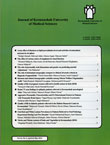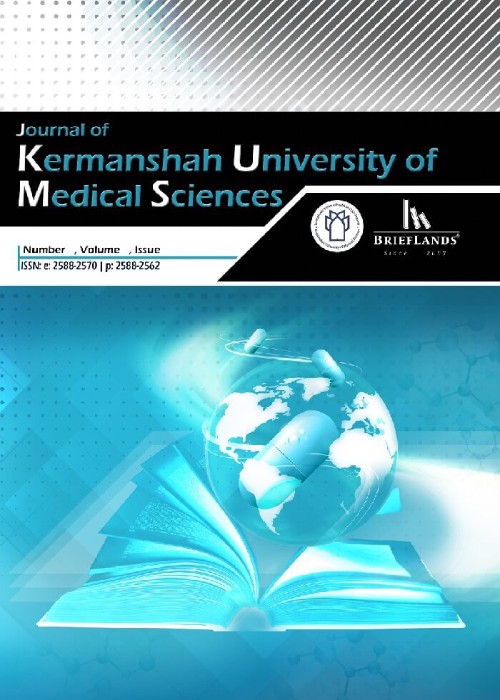فهرست مطالب

Journal of Kermanshah University of Medical Sciences
Volume:20 Issue: 1, 2016
- تاریخ انتشار: 1395/02/05
- تعداد عناوین: 8
-
-
Pages 1-5IntroductionThe use of antioxidants before high-intensity training, which leads to the release of free radicals and muscle injuries, can result in reduced damage during exercise. Accordingly, in this study, we aimed to evaluate the effect of selenium supplement intake on oxidative stress, following exhaustive aerobic exercise among young physically-active females.MethodsIn this quasi-experimental study, 20 healthy girls (age: 23.6±1.5 years, height: 1.61±0.0126 m, and weight: 60.2±7.13 kg) were randomly divided into exercise (n=10) and supplement exercise (n=10) groups. The participants were asked to consume selenium supplements (200 µg/day) for a period of 14 days. The Bruce protocol stress test was conducted 24 h after the final intake of supplements and primary blood collection (in a fasting state). Also, immediately after performing the Bruce test, the second blood samples were drawn from the subjects. Oxidative stress markers (i.e., creatine kinase, lactate dehydrogenase, and malondialdehyde levels) were measured at each stage of blood sampling and were compared between the groups using paired t-test. Data analysis was performed by SPSS (version 18). P-value less than 0.05 was considered statistically significant.ResultsThe results indicated that exhaustive aerobic exercise could cause a significant increase in creatine kinase, lactate dehydrogenase, and malondialdehyde levels. The comparison between the control and intervention groups suggested the significant effect of selenium supplementation on declining of lactate dehydrogenase level (PConclusionThe results of the present study demonstrated that selenium supplements could reduce oxidative stress, induced by exhaustive physical exercise.Keywords: Selenium, Muscle injury, Malondialdehyde, Creatine kinase, Lactate dehydrogenase
-
Pages 6-9IntroductionInadequate sleep hygiene may result in difficulties in daily functioning; therefore, reliable scales are important to measure sleep hygiene. The purpose of this study was to assess the psychometric properties of the Persian version of Sleep Hygiene Index (SHI) in the male population.MethodsIn this study, 787 men, who were selected by cluster random sampling, filled out the SHI, Pittsburgh Sleep Quality Index (PSQI), Epworth Sleepiness Scale (ESS), and Insomnia Severity Index (ISI). A subset of the participants (20%) completed SHI after a 46 week interval to measure testretest reliability. Then, the Pearson productmoment correlation coefficients of SHI against PSQI, ESS, and ISI were computed to demonstrate the construct validity of SHI. The factor structure of SHI was evaluated by explanatory factor analysis.ResultsThe interclass correlation coefficient was 0.85, and SHI was found to have a good testretest reliability (r = 0.86, pConclusionThe Persian version of SHI can be considered a reliable tool for evaluating sleep hygiene in the male population in Persian countries.Keywords: Sleep Hygiene Index, Validity, Reliability, Men, Persian
-
Pages 10-16IntroductionDisabled-adjusted Life Year (DALY) makes it possible to calculate the time and duration of the disease and its non-fatal consequences along with the time lost due to premature death. This study was aimed to estimate the burden of Road Traffic Accidents (RTA) in Kermanshah Province.MethodsTo determine the mortality related to road-traffic accidents as well as Years of Life Lost (YLL) due to premature death and to calculate the incidence of non-fatal injuries and Years Lost due to Disability (YLD), the data from National Death Registration and Forensics Medicine were used. The causes of death and nature of non-fatal injuries were classified using International Classification of Diseases 10 codes (ICD-10) and Global Burden of Diseases 2010 (GBD-2010). The YLL, YLD and DALY were estimated according to the guidelines of GBD 2010, and age and sex composition was taken from the National Statistical Center for the year 2010.ResultsThe mean age of the patients was 34.2±18.2 years. Overall, 70.8% of the subjects were male and the rest were female. The mortality and non-fatal injury rates of RTAs in Kermanshah province were 51.3 and 283.6 per 100,000 population, respectively. The YLLs due to premature death were 46613 years (24.5 per 1000) and the YLDs were found to be 3404.9 years (1.7 per 1000). The DALYs were found to be 50017.9 years (26.2 per 1000) in both genders. The highest DALY rate in both genders was reported for the age group 30-34 (32.4 per 1000). More than 93% of DALYs were related to YLL (24.5 per 1000).ConclusionGiven the DALY >50000 years attributed to RTAs, the share of more than 93% YLL in the DALY rate, and the fact that most RTAs occur in the men and age group 15-44 years, it is necessary to implement all effective and multisectoral preventive measures, especially for this group, such as use of helmet and seatbelts, speed limit enforcement, better road design, and manufacturing of high quality cars.Keywords: Burden of Road Traffic Accidents, DALY, Kermanshah
-
Pages 17-20IntroductionInfluenza can cause more severe diseases and higher rate of morbidity and mortality in the elderly population. Therefore, they should receive influenza vaccine annually. However, the host response to vaccine is less in older individuals. On the other hand, selenium can act as a stimulator of the immune system and cause increased immunity and response to vaccine. This study was carried out to determine the effect of selenium on antibody production against influenza vaccine. By verifying this effect, selenium can be recommended as an adjuvant therapy in the elderly.MethodsA total of 110 subjects were selected at Infectious Diseases Research Center of Imam Reza Hospital in Kermanshah. They were divided into two groups of adjuvant (N=56) and placebo (N=54). The adjuvant group received influenza vaccine and selenium tablet. The placebo group received influenza vaccine and placebo tablet. Venous blood samples were taken before and four weeks after vaccination and the results were compared between the two groups.ResultsSeroconversion, seroprotection, and geometric mean titer (GMT) for three strains (H1N1, H3N2, and B) were assessed. The seroconversion and GMT rates against influenza B vaccine component were significantly higher in adjuvant group than placebo group.ConclusionConsidering the ability of selenium in induction of a better response to influenza vaccine in older people as well as its low cost and accessibility, selenium can be used to increase antibody level in such cases.Keywords: Influenza, Vaccine, Selenium, Elderly Patients
-
Pages 21-25IntroductionHepatitis B is a potentially life-threatening infection that causes acute infection and chronic hepatitis with progression to cirrhosis and hepatocellular carcinoma (HCC). Interleukin-12 (IL12) is responsible for activation of Th1 immune responses, leading to possible clearance of HBV infection from the hosts body. The hosts immune-genetic background plays an important role in the pathogenesis of infectious diseases. The aim of the present study was to investigate the association of interleukin 12A single nucleotide polymorphism (rs568408 G/A) with chronic HBV infection.MethodsIn this case-control study, 120 chronic HBV patients and 120 healthy controls were studied from 2013 to 2015. Genotype analysis was performed using polymerase chain reaction-restriction fragment length polymorphism (PCR-RFLP) method.ResultsThe genotype distribution of IL12 rs568408 G/A was not significantly different between the chronic HBV patients and healthy controls. The frequency rates of the IL12 gene polymorphism at position rs568408 included GG (64.2%), AG (33.3%), and AA (2.5%) in the HBV patients and GG (68.3%), AG (29.2%), and AA (2.5%) in healthy controls (p=0.728).ConclusionThe results suggested no significant association between IL12A rs568408 G/A genotypes and chronic hepatitis B virus infection.Keywords: Chronic hepatitis B infection_single nucleotide polymorphisms_Interleukin 12_Iran
-
Pages 26-29IntroductionWork pressure and excessive workload can jeopardize and impair the peoples health. One of these impairments is musculoskeletal disorders. Among these disorders, low back pain is the most common and most costly problem. The purpose of this study was to investigate the relationship between workload and prevalence of low back pain in assembly line workers of a car manufacturing factory.MethodsThis cross-sectional study was conducted on 69 workers working in the assembly line of a factory. Data collection tools included three questionnaires: demographic questionnaire, NASA Task Load Index (NASA-TLX) and Cornell Musculoskeletal Discomfort Questionnaire (CMDQ). Data were analyzed by descriptive and inferential (T-test and One-way ANOVA) statistics.ResultsOf the workers, 72.5% were female. The average total workload was 71.42% and the prevalence of musculoskeletal disorders in low back was 43.37%. The results of the analysis of relationship between workload and the prevalence of low back pain showed a significant relationship between physical/ mental workload and the incidence of low back pain (PConclusionThe more is the workload on the person, the greater is the risk of low back pain. Measures such as increasing the number of workers to distribute the workload, slowing the work pace, having work-rest periods for workers, improving psychological conditions of work, etc. can be useful in this regard.Keywords: Workload, low back pain, assembly line workers, relationship
-
Pages 30-36IntroductionInequality is prevalent in all sectors, particularly in distribution of and access to resources in the health sector. The aim of current study was to investigate the distribution of physicians and hospital beds in Iran in 2001, 2006 and 2011.MethodsThis retrospective, cross-sectional study evaluated the distribution of physicians and hospital beds in 2001, 2006 and 2011 using Gini coefficient and Lorenz curve. The required data, including the number of physicians (general practitioners and specialists), number of hospital beds and number of hospitalized patients were obtained from the statistical yearbook of Iranian Statistical Center (ISC). The data analysis was performed by DASP software.ResultsThe Gini Coefficients for physicians and hospital beds based on population in 2001 were 0.19 and 0.16, and based on hospitalized patients, were 0.48 and 0.37, respectively. In 2006, these values were found to be 0.18 and 0.15 based on population, and 0.21 and 0.21 based on hospitalized patients, respectively. In 2011, however, the Gini coefficients were reported to be 0.16 and 0.13 based on population, and 0.47 and 0.37 based on hospitalized patients, respectively. Although distribution status had improved in 2011compared with 2001 in terms of population and number of hospitalized patients, there was more inequality in distribution based on the number of hospitalized patients than based on population.ConclusionThis study indicated that inequality in distribution of physicians and hospital beds was declined in 2011 compared with 2001. This distribution was based on the population, so it is suggested that, in allocation of resource, the health policymakers consider such need indices as the pattern of diseases and illness-prone areas, number of inpatients, and mortality. -font-family: Calibri;mso-ansi-language:EN-US;mso-fareast-language:EN-US;mso-bidi-language: FA'> The results suggested no significant association between IL12A rs568408 G/A genotypes and chronic hepatitis B virus infection.Keywords: Physician, Hospital Beds, Gini Coefficient, Inequality
-
Pages 37-42IntroductionThe effect of dust on human health has been confirmed according to the geographical location of Iran and the existence of this phenomenon in most provinces, particularly the western and southern provinces. This review discusses the role of proper nutrition in reducing the harmful effects of dust on human health.MethodsIn this systematic review, the published articles were found through searching the electronic databases of the articles and books related to the topic. The relevant articles published from 1990 to 2015 were collected using the search keywords, including air pollution, particular matter, nutrition, etc.ResultsEpidemiological studies have shown that dust has harmful effects on the body's systems and vital organs, including the digestive system, heart and lungs. A diet containing adequate amounts of vitamins, minerals, antioxidants and omega-3 can reduce these effects.ConclusionGiven the harmful effects of dust on human health, more studies are required to determine the dimensions of these effects and ways to deal with this phenomenon so that the policy makers will be able to manage the environmental effects of dust on human health in the best way possible.Keywords: Dust, nutrition, health, harmful effects


